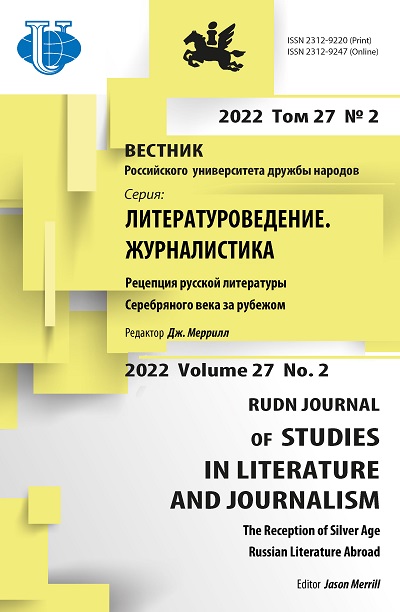John Cournos - Fedor Sologub’s Translator into English and the Role Played by Zinaida Vengerova
- Authors: Smith M.S.1, Yushkova E.V.1
-
Affiliations:
- Issue: Vol 27, No 2 (2022): THE RECEPTION OF SILVER AGE RUSSIAN LITERATURE ABROAD
- Pages: 286-298
- Section: LITERARY CRITICISM
- URL: https://journals.rudn.ru/literary-criticism/article/view/31457
- DOI: https://doi.org/10.22363/2312-9220-2022-27-2-286-298
- ID: 31457
Cite item
Full Text
Abstract
Fedor Sologub entered British literary consciousness only after the onset of WWI. The British-Russian war alliance was auspicious for the translation of Russian literature, bringing about what John Cournos termed a “Russian Boom.” In 1915 alone, two translated collections of Sologub’s short stories appeared. This paper examines the British reception of Sologub, with a focus on John Cournos (1881-1966), one of Sologub’s earliest and most prolific translators, and the role played by Zinaida Vengerova (1867-1941) as mediator between translator and author. In her correspondence with Sologub, Vengerova promotes Cournos as translator. A more pressing concern for Vengerova was to convince Sologub to make Cournos his “authorized” translator. This paper also argues that the reception of Sologub in Britain must be contextualized in terms of war propaganda. Politically, the British government prioritized the promotion of brotherly feeling between the two allies and a positive opinion of Russia. Prior to the war alliance, the British public held a negative opinion of tsarist Russia, of its government and culture. The controversial nature of Sologub’s writing complicated his critical reception.
About the authors
Marilyn Schwinn Smith
Email: msmith@amherst.edu
PhD in Comparative Literature, Independent Scholar
Elena V. Yushkova
Author for correspondence.
Email: elyushkova@yandex.ru
ORCID iD: 0000-0002-7388-1123
Candidate of Arts, Independent Scholar, Research Associate at Five College Women’s Studies Center
References
- Anderson, D.P. (2000). Fedor Sologub and the Dance (PhD dissertation). Cornell University. Ann Arbor, MI: UMI.
- Ayers, D. (2018). Modernism, Internationalism and the Russian Revolution. Edinburgh: Edinburgh UP, 2018.
- Cournos, J. (1916, August). Feodor Sologub as a Dramatist. The Drama 23. P. 329-345.
- Cournos, J. (1915, Septmber 1). Feodor Sologub. The Fortnightly Review, 104, 480- 490.
- Cournos, J. (1916). “Translator’s Preface.” Feodor Sologub. The Little Demon. London: Secker’s.
- Cournos, J. (1916). Feodor Sologub. The Egoist 3:1 [illustrated by Roald Kristian]. January, 1 . P. 4-5.
- Fletcher, J.G. (1916, November 1). Sologub’s ‘Created Legend’. The Egoist 3.11, 167- 168.
- Goodale, R.H. (1932). Schopenhauer and Pessimism in Nineteenth-Century Literature. PMLA, 1(47), 241-261.
- Gould, G. (1916, April 8). New Novels [The Little Demon by Feodor Sologub, The River of Life by Alexander Kuprin, The Duel by Alexander Kuprin, The Mantle by Nicholas Gogol]. The New Statesman, 645-646.
- Keys, R.J. (2002). Narratorial Structure and Semantic Authority in the Short Stories of Fedor Sologub. Slavonica, 1(8), 7-19.
- Martin, N. (2006). Nietzsche as Hate-Figure in Britain’s Great War: ‘The Execrable Neech’. In Fred Bridgham (Ed.), The First World War as a Clash of Cultures (pp. 144-166). Rochester, NY: Camden House.
- Modernist Journals Project. Solomon S. Introduction to the New Freewoman and the Egoist. Retrieved June 6, 2021, from https://modjourn.org/introduction-to-the-new-freewomanand-the-egoist/ [Accessed 12/06/2021]
- Rhys, E. (1915, September). Sologub. The Welsh Outlook, a Monthly Journal of National Social Progress, 2(9), 342-344.
- Sologub, F. (1913, December 20). The White Dog. The New Statesman, II (37), 339-340.
- Sologub, F. (1914, June 27). The Hoop. The New Statesman, III(64), 371-372.
- Sologub, F. (1915). The Sweet-Scented Name and Other Fairy Tales, Fables and Stories. London: Constable and Co.; New York: Putnam’s.
- Sologub, F. (1915, 1916, 1928). The Old House, and Other Tales. London, M. Secker; New York: Knopf.
- Sologub, F. (1916). The Created Legend. New York: Frederick A. Stokes Co; London: M. Secker.
- Sologub, F. (1916). The Little Demon. London: M. Secker; New York: A.A. Knopf.
- Sologub, F. (1916, August 23). The Triumph of Death. A Tragedy in Three Acts with a Prologue. The Drama, 346-384.
- Sologub, F. (1916, December). Little Tales. Egoist, 3(12), 188-190.
- Sologub, F. (1916, January 1). Little Tales. The Egoist, 3(1), 8-9.
- Sologub, F. (1916, November). Two Candles, One Candle, Three Candles; He Became Better; Three Gobs of Spit; Fairy Tales in the Garden, and Fairy Tales at Court; A Marriage; Captive Death; The Wandering Jew. The Egoist, 3(11), 175.
- Sologub, F. (1916, October). Dreams. An authorized translation by Mr. John Cournos. The Welsh Outlook, a Monthly Journal of National Social Progress, 3(10), 329. [“Fuel” “The Bent-Kneed One”]
- Sologub, F. (1917). Little Tales. Cleveland: Printed at the Clerk’s Private Press.
- Sologub, F. (1917, May). Eyes, Eyelings, Stare-Eyes. Egoist, 4(4), 54.
- Sologub, F. (1962). The Little Demon. London: New English Library.
- Sologub, F. (1962, 1970). The Petty Demon. NY: Random House; Bloomington, IN: Indiana UP.
- Sologub, F. (1983). The Petty Demon. Ann Arbor, MI: Ardis Press.
- Thatcher, D.S. (1970). Nietzsche in England 1890-1914: The Growth of a Reputation. Toronto: U. of Toronto P.
- The Nation [London]. (1915, July 3). 17(14), 464, 466.
- The Nation [London]. (1915, July 3). 17(14), 464.
- Venuti, L. (1995). The Translator’s Invisibility: A History of Translation. New York: Routledge.
- West, J. (1915, August 14). “Translated from the Russian”. New Statesman, 447-448.
Supplementary files















